A Python package for data analysis and model optimization.
Project description
 apyxl
apyxl
The apyxl package (Another PYthon package for eXplainable Learning) is a simple wrapper around xgboost, hyperopt, and shap. It provides the user with the ability to build a performant regression or classification model and use the power of the SHAP analysis to gain a better understanding of the links the model builds between its inputs and outputs. With apyxl, processing categorical features, fitting the model using Bayesian hyperparameter search, and instantiating the associated SHAP explainer can all be accomplished in a single line of code, streamlining the entire process from data preparation to model explanation.
Current Features
- Automatic One-Hot-Encoding for categorical variables
- Bayesian hyperparameter optimization using
hyperopt - Simple explainability visualizations using
shap(beeswarm,decision,force,scatter) - Focus on classification and regression tasks
Planned Enhancements
- Time-series normalization
- A/B test analysis capabilities
- Formalizing the links between the two latest concepts, and comparison with econometrics techniques, like difference-in-differences, panel analysis and regression discontinuity. I believe these methods are closely related, and perhaps variations of a more general approach
NEW: I have started comparing apyxl with the discussed econometrics methods, beginning with Regression Discontinuity Design, have a look on this notebook.
Installation
To install the package, use:
pip install apyxl
Basic Usage
1. Regression
from apyxl import XGBRegressorWrapper
from sklearn.datasets import fetch_california_housing
X.shape, y.shape
>>> ((20640, 8), (20640,))
model = XGBRegressorWrapper().fit(X, y)
# defaults to r2 score
model.best_score
>>> 0.6671771984999055
# Plot methods can handle internally the computation of the SHAP values
model.beeswarm(X=X.sample(2_500))
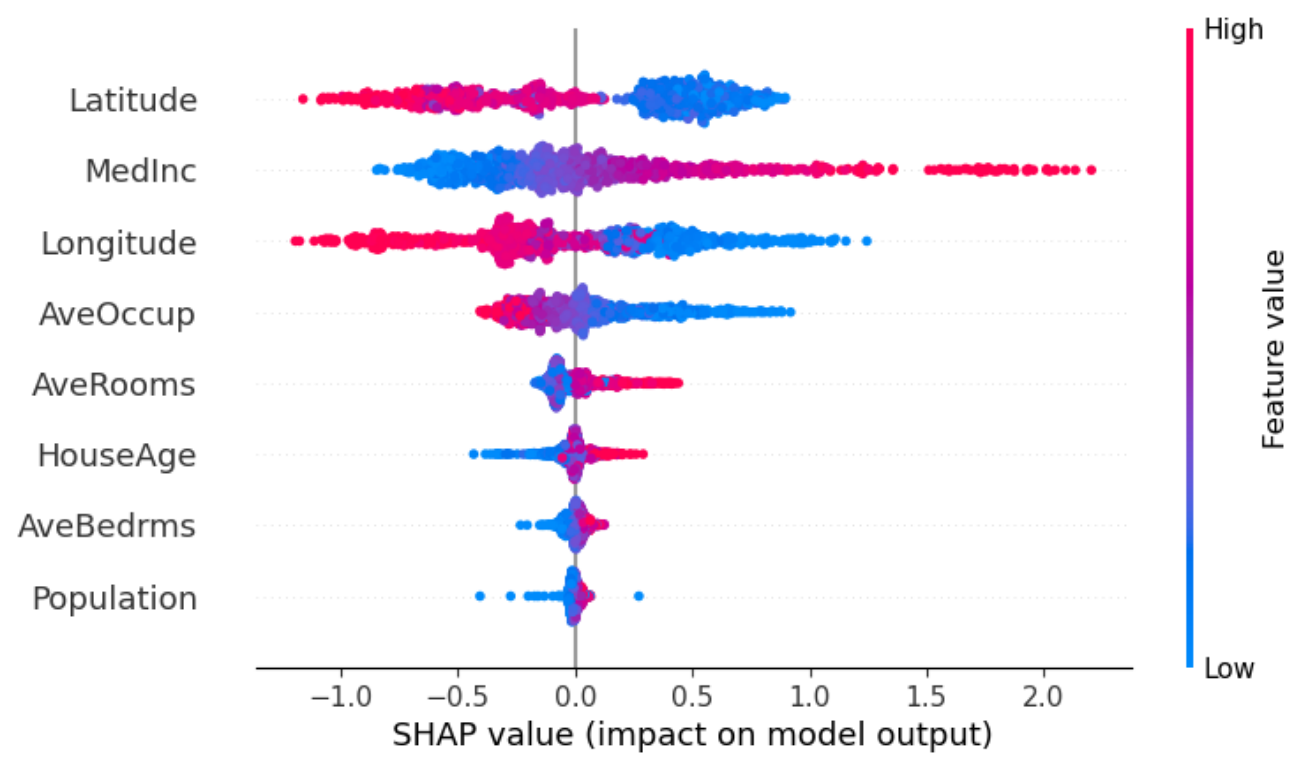
model.scatter(X=X.sample(2_500), feature='Latitude')
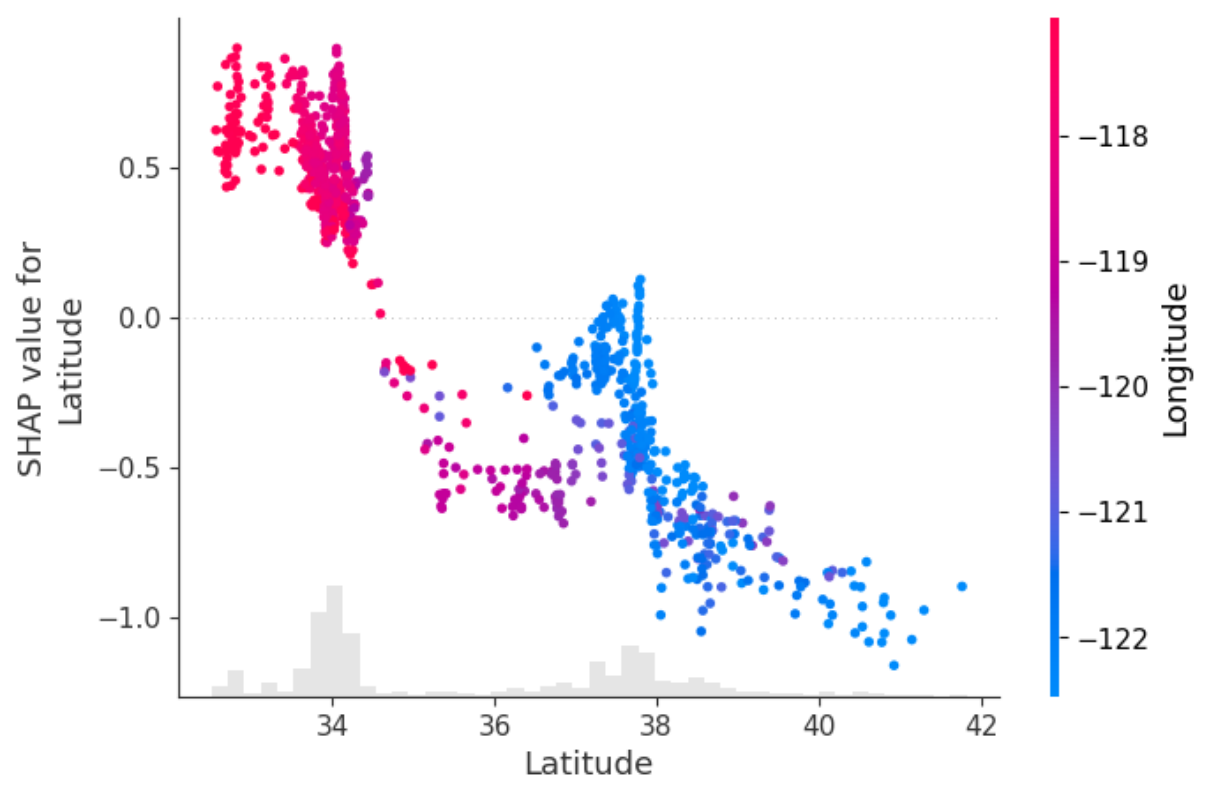
2. Classification
from apyxl import XGBClassifierWrapper
from sklearn.datasets import fetch_covtype
X, y = fetch_covtype(as_frame=True, return_X_y=True)
y -= 1
y.unique()
>>> array([4, 1, 0, 6, 2, 5, 3])
X.shape, y.shape
>>> ((581012, 54), (581012,))
# To speed up the process, Bayesian hyperparameter optimization can be performed on a subset of the
# dataset. The model is then fitted on the entire dataset using the optimized hyperparameters.
model = XGBClassifierWrapper().fit(X, y, n=25_000)
# defaults to Matthews correlation coefficient
model.best_score
>>> 0.5892932365687379
# Computing SHAP values can be resource-intensive, so it's advisable to calculate them once for
# multiple future uses, especially in multiclass classification scenarios where the cost is even
# higher compared to binary classification (shap values shape equals (n_samples, n_features, n_classes))
shap_values = model.compute_shap_values(X.sample(1_000))
shap_values.shape
>>> (1000, 54, 7)
# The `output` argument selects the shap values associated to the desired class
model.beeswarm(shap_values=shap_values, output=2, max_display=15)

model.scatter(shap_values=shap_values, feature='Elevation', output=4)
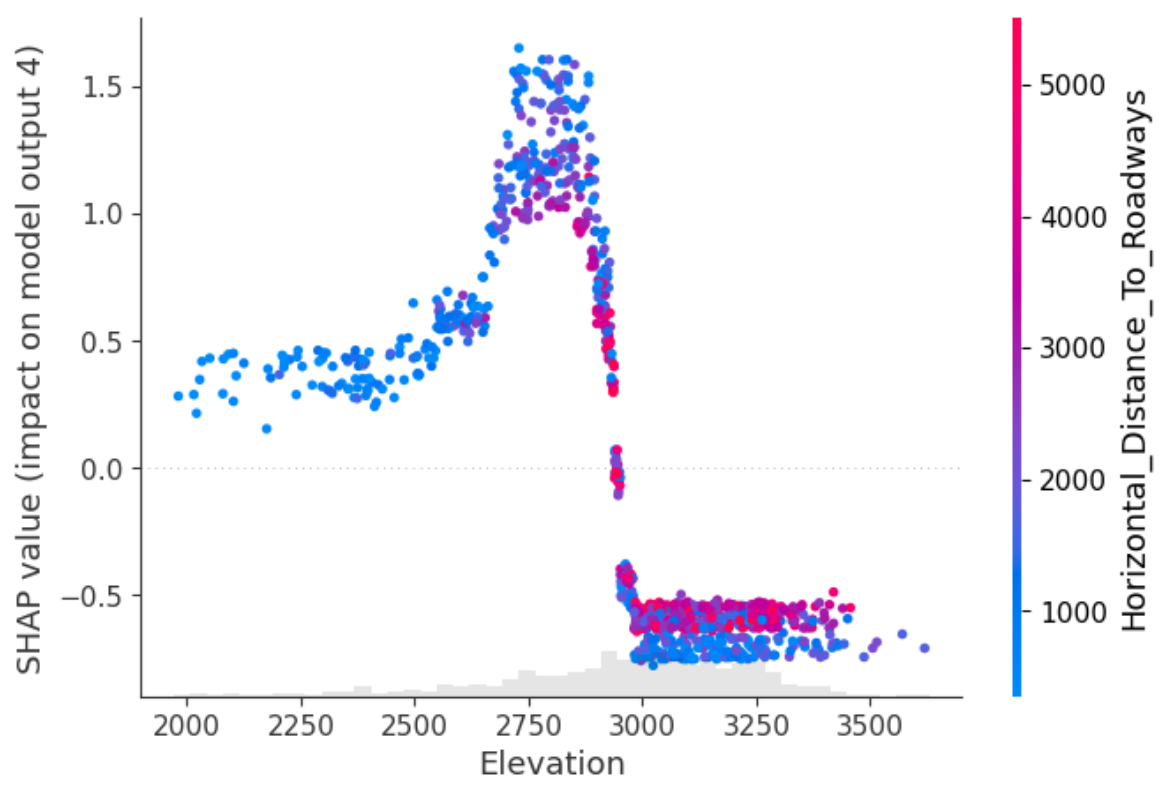
3. Time Series Normalization - A/B tests
3.1. Time Series Normalization
Weather normalization for time series is a trend discovery analysis that has long been used in weather-dependent applications (such as energy consumption or air pollution). My research suggests that it is equivalent to a SHAP analysis, treating time as a simple numeric variable. Tree-based methods like gradient boosting are particularly well-suited for discovering breakpoint changes, as they recursively split the dataset along one variable and one threshold.
import matplotlib.pyplot as plt
import numpy as np
import pandas as pd
from apyxl import XGBRegressorWrapper
n = 8760
time = pd.date_range(start='2024-01-01', freq='h', periods=n)
# Generate two correlated time series, `a` and `b`
cov = [[1, 0.7], [0.7, 1]]
mean = [0, 5]
df = np.random.multivariate_normal(cov=cov, mean=mean, size=n)
df[:, 1] *= 2
# Shift time serie `b` on a continuous subset of the period
df[6000:7000, 1] += 2
df = pd.DataFrame(df, columns=['a', 'b'], index=time)
df.plot(lw=0.7)
plt.show()
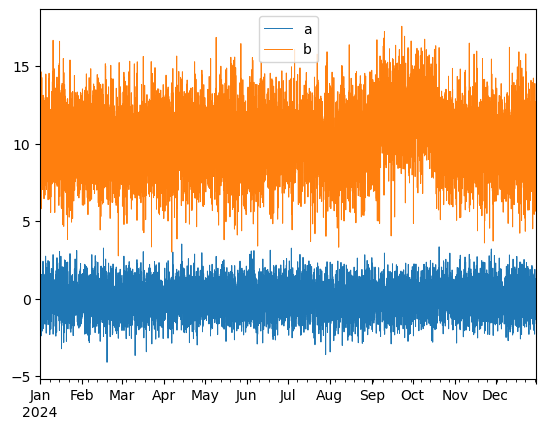
# process time index as a simple numeric variable, i.e. the number of
# days since the beginning of the dataset (could have been another time unit)
df['time_numeric'] = ((df.index - df.index.min())/pd.Timedelta(days=1)).astype(int)
# `apyxl` can be then used as:
target = 'b'
X, y = df.drop(columns=target), df[target]
model = XGBRegressorWrapper(random_state=0).fit(X, y)
model.scatter(X, feature='a')
model.scatter(X, feature='time_numeric')
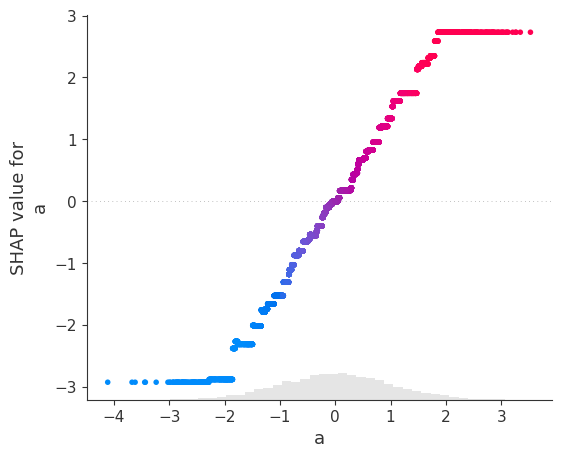
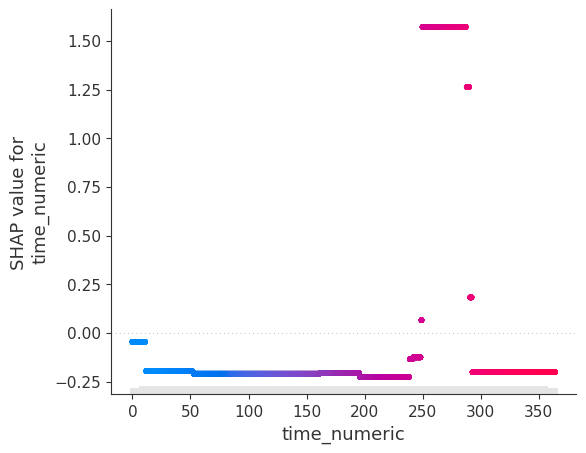
The fitted XGBoost regressor manages to capture the linear relationship between a and b (with the exception of extreme values) as well as the temporary, time-localized shift between the two time series. This trend, in other words the behavior of b that can't be explained by a, can be isolated:
shap_values = model.compute_shap_values(X)
pd.Series(shap_values[:, 'time_numeric'].values, index=X.index).plot(title='time series `b` normalized by `a`')
plt.show()
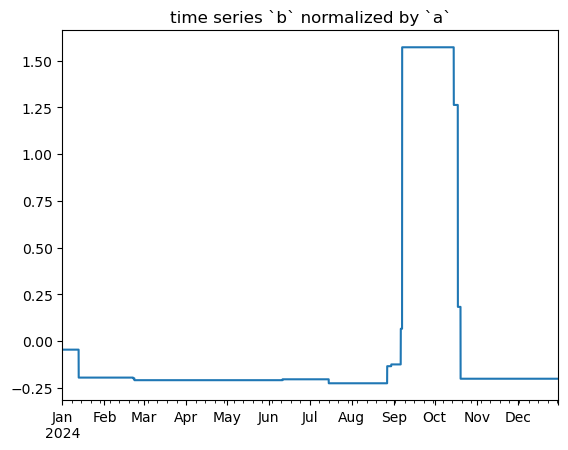
3.2. A/B tests
Let's now look at our dataset in a different way:
import matplotlib.pyplot as plt
import numpy as np
import pandas as pd
from apyxl import XGBRegressorWrapper
n = 8760
time = pd.date_range(start='2024-01-01', freq='h', periods=n)
# Generate two correlated time series, `a` and `b`
cov = [[1, 0.7], [0.7, 1]]
mean = [0, 5]
df = np.random.multivariate_normal(cov=cov, mean=mean, size=n)
df[:, 1] *= 2
# Shift time serie `b` on a continuous subset of the period
df[6000:7000, 1] += 2
df = pd.DataFrame(df, columns=['a', 'b'], index=time).rename_axis(index='time', columns='id')
df = df.stack().rename('value').reset_index().set_index('time')
df['time_numeric'] = ((df.index-df.index.min())/pd.Timedelta(days=1)).astype(int)
df.sample(5)
>>> id value time_numeric
>>> time
>>> 2024-12-24 05:00:00 a 1.944142 358
>>> 2024-09-01 11:00:00 a -0.528874 244
>>> 2024-10-26 22:00:00 b 7.377142 299
>>> 2024-04-17 03:00:00 a 0.744991 107
>>> 2024-12-15 11:00:00 b 8.370796 349
We are now dealing with less structured data, with a value of interest and two different ids. Does the behavior of value change over time differently according to the ids?
target = 'value'
X, y = df.drop(columns=target), df[target]
model = XGBRegressorWrapper(max_evals=25).fit(X, y)
model.beeswarm(X)
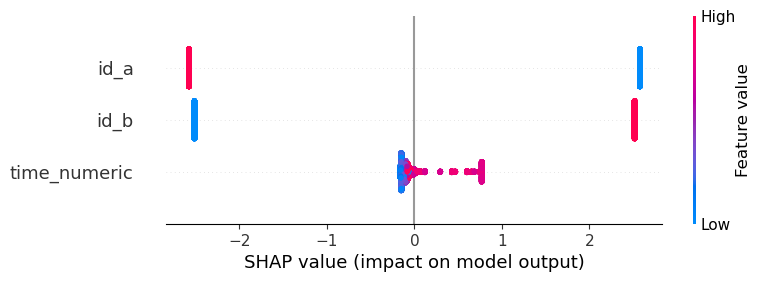
model.scatter(X, feature='time_numeric')
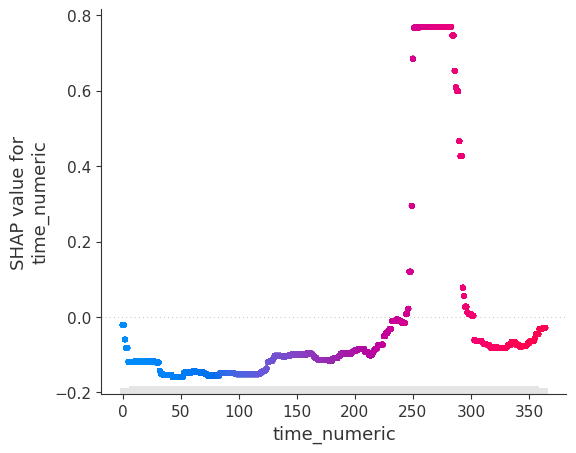
The SHAP analysis is clearly able to isolate relative changes of correlated time series over time.
The package's approach, using tree-based models like XGBoost for time series normalization and A/B testing, shares similarities with econometric techniques such as difference-in-differences (DiD) and fixed effects models. These methods aim to isolate the impact of treatments or events over time while controlling for confounding factors.
A key difference lies in the specification of events and variable impacts. In DiD, users must explicitly define event timing through dummy variables and quantify covariate effects through traditional econometric models. In contrast, this package's method can automatically discover relevant time periods without relying on prior user inputs and uses SHAP values to quantify variable impacts. This machine learning-based approach offers more flexibility by uncovering hidden events and interactions without explicit user-defined structures, while still providing interpretable results analogous to econometric models.
A future comparison between this approach and traditional econometric methods could yield valuable insights, particularly regarding non-linear relationships and the capture of complex interactions in time series data.
Note
Please note that this package is still under development, and features may change or expand in future versions.
Project details
Download files
Download the file for your platform. If you're not sure which to choose, learn more about installing packages.
Source Distribution
File details
Details for the file apyxl-0.1.3.tar.gz.
File metadata
- Download URL: apyxl-0.1.3.tar.gz
- Upload date:
- Size: 14.8 kB
- Tags: Source
- Uploaded using Trusted Publishing? No
- Uploaded via: twine/5.1.1 CPython/3.12.5
File hashes
| Algorithm | Hash digest | |
|---|---|---|
| SHA256 | 065f09548bd164132b7fe51c70d390ad000c3498a04ca9d6dd87fec44618617b |
|
| MD5 | 1569afdc0d09eeb300f49c5bb2d9d37e |
|
| BLAKE2b-256 | 24b679fd4ac9ab6d5098c2bc06f1a78426f7118fa45340f7d3fa2cdc8b24f5e8 |












